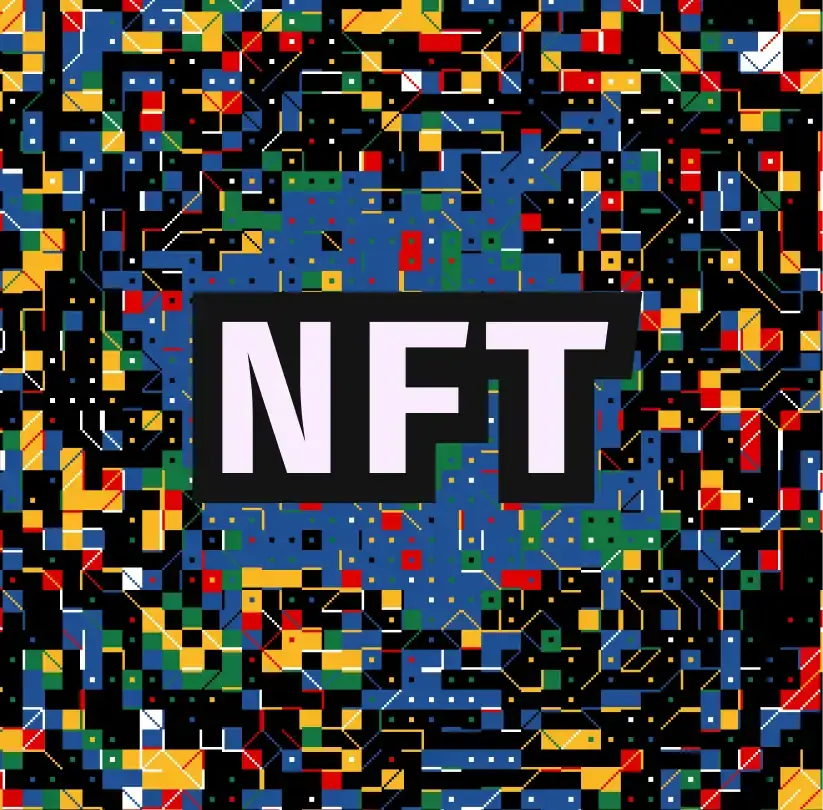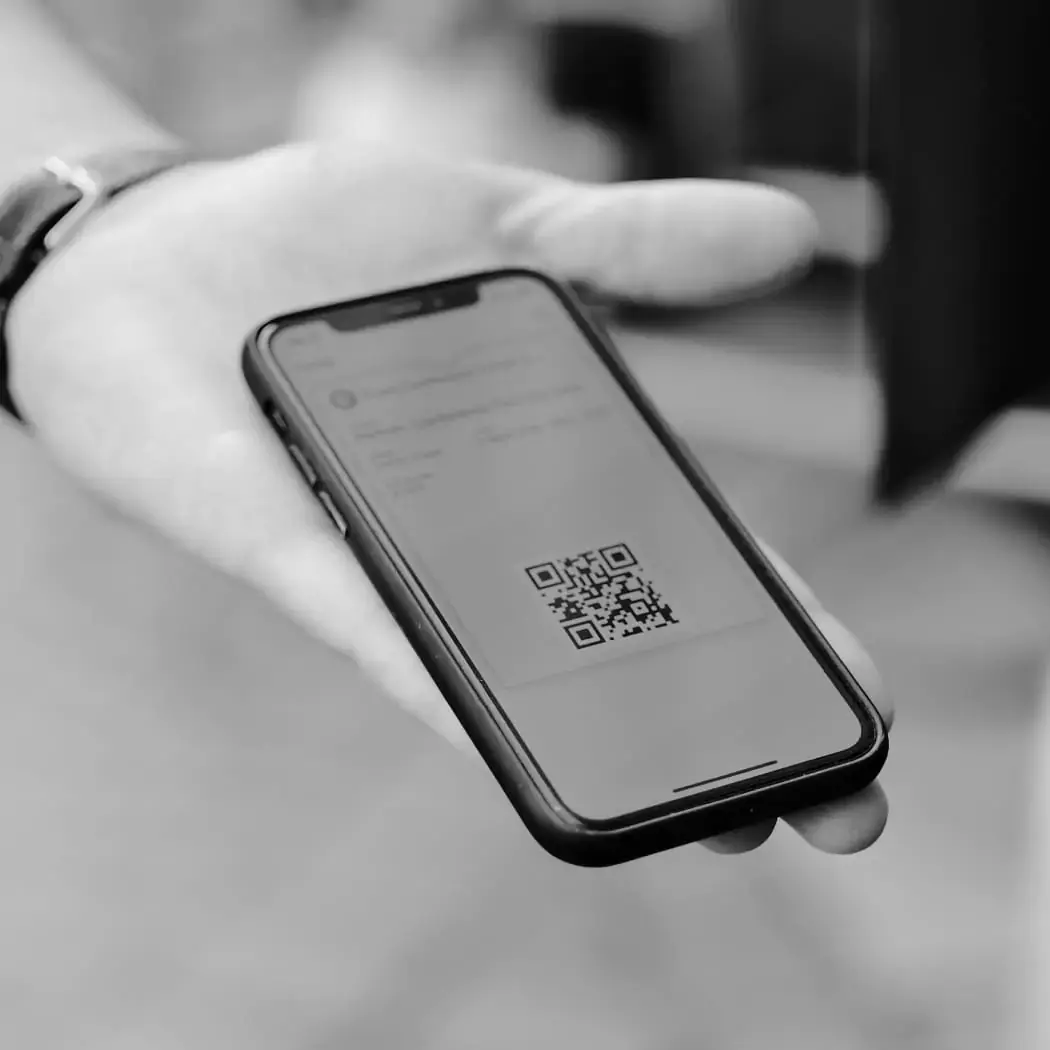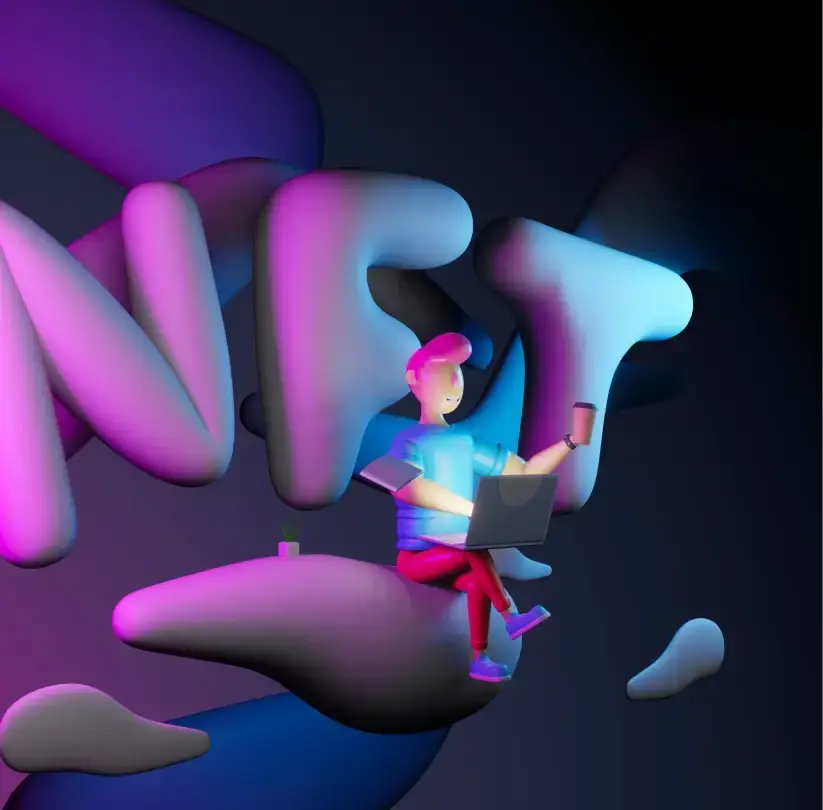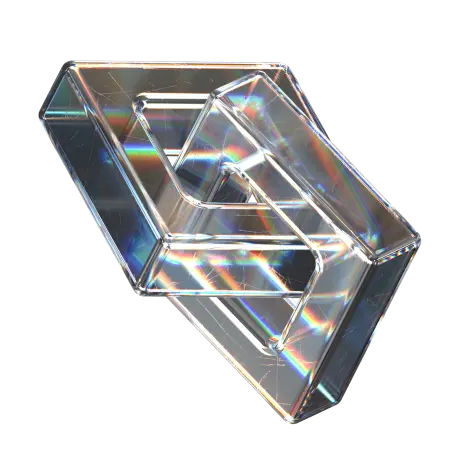Building an NFT (non-fungible tokens) marketplace presents a great opportunity for entrepreneurs in the realm of digital collectibles and blockchain. NFT marketplaces serve as instrumental catalysts in driving the mass adoption of Web3 and facilitate a significant part of on-chain transactions.
NFT marketplace platform development has many advantages, including enhanced control and customization, elevated user experience, fortified security measures, diversified revenue streams, and future-proofing capabilities.
In this guide, we will explore what is NFT marketplace and consider every stage of NFT marketplace platform development from inception to completion. These stages include market research, blockchain launching, smart-contracts creation, and others.
What is NFT Marketplace?
Before we answer how to build an NFT marketplace, it’s vital to consider the definition of such a marketplace.
An NFT marketplace ia a virtual hub for trading and acquiring non-fungible tokens – digital assets that represent the proof of authenticity, ownership of digital content or unique items using blockchain technology (art, music, videos, collectibles).
Based on insights from Technavio’s research, the market is forecasted to witness a substantial increase of USD 147.24 billion between 2021 and 2026. Given this projection, establishing an NFT marketplace emerges as a highly promising venture for entrepreneurial pursuits.
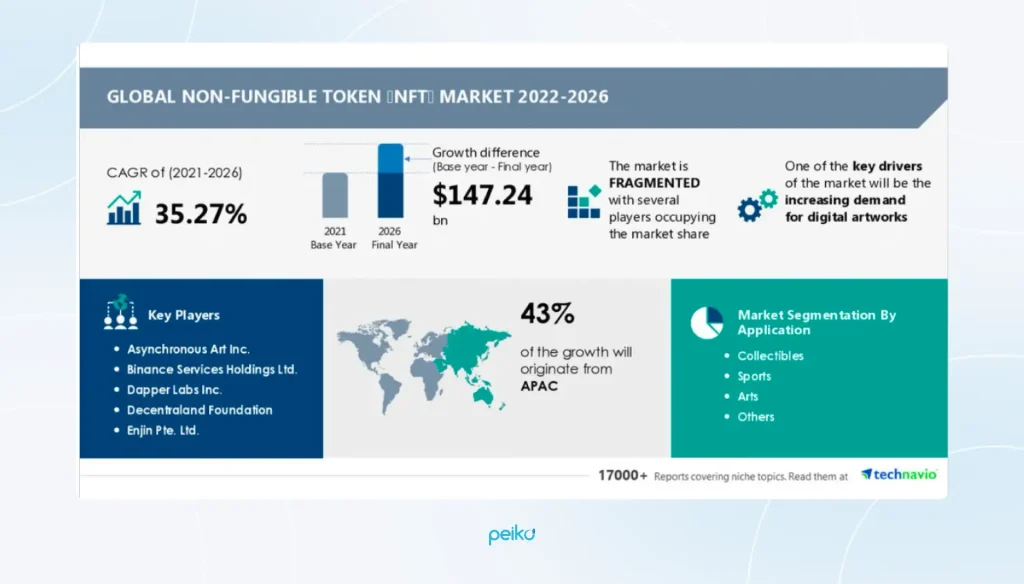
There exists a variety of NFT marketplaces, each with its own set of regulations, fees, and payment methods. Here are a few noteworthy examples:
- OpenSea: Widely regarded as one of the premier NFT platforms globally, OpenSea boasts an extensive array of digital artworks spanning music, imagery, sports collectibles, and more. It supports over 150 different digital currencies.
- Nifty Gateway: Renowned for its association with high-profile sales such as Beeple’s CROSSROAD and Pak’s The Merge, Nifty Gateway has risen to prominence in the NFT landscape. Its success may inspire those considering launching their own NFT platform.
- Rarible: Similar to OpenSea, Rarible is celebrated for its diverse range of artworks and collections available for purchase. Notably, Rarible is community-owned and firmly committed to decentralization principles.
- SuperRare: Recognized for its emphasis on artistry, SuperRare offers a platform reminiscent of an art gallery, providing a curated selection of artworks for enthusiasts and collectors alike.
The architecture of an NFT marketplace
Creating a successful NFT marketplace requires a well-structured architecture that supports key functionalities. The following components are essential for the effective operation of an NFT marketplace
NFT MetaData
NFT metadata contains crucial information about each token, such as its title, description, attributes, and ownership history. This data is imperative for displaying details about the asset.
Digital wallet
A digital wallet is necessary for users to store, manage, and trade their NFTs. It allows easy access to their assets and facilitates transactions within the marketplace by securely holding their private keys.
Blockchain integration
Blockchain technology underpins the functioning of an NFT marketplace, providing a secure, decentralized ledger for recording transactions.
Smart contract
Smart contracts are self-executing code that automates the transaction process, ensuring that agreements are fulfilled without intermediaries.
Token minting
Token minting is the process of creating new NFTs and adding them to the marketplace. This involves converting digital assets into unique tokens on the blockchain.
IPFS (interplanetary file system)
It’s a decentralized storage solution that allows for securing NFT assets, such as images and videos. Using IPFS, NFT marketplaces ensure that digital content is accessible and resistant to censorship.
Each component is critical in building a robust NFT marketplace that provides users an engaging and seamless trading experience.
How does an NFT marketplace work?
It basically works on the blockchain at the heart of ensuring ownership and the authenticity of any particular digital asset. When any user wants to sell an NFT, he lists it on the marketplace, providing essential details regarding metadata from the token, price, and auction timeframes, if applicable. Smart contracts automate the transaction process so that when conditions are met-a straight sale or through a bidding system – the ownership transfers.
Buyers browse various NFTs by category, artist, or collection. Once they find an asset they would like to buy, the transaction is executed with their digital wallet, which securely holds their cryptocurrency to pay for the NFT. When this sale goes through, the NFT will be minted on the blockchain, ownership recorded in the buyer’s name, and the seller will get paid.
Why are NFTs popular?
NFTs are rapidly gaining popularity, with their robust security, transparency, authentication models, and seamless processing serving as key drivers behind this surge. This leads to the NFT marketplaces dominating the charts. But what exactly drives the fascination with NFTs?
- Ownership and provenance: NFTs provide a secure way of proving ownership and authenticity of digital assets, which is highly appealing both to collectors and artists.
- Unique value: Due to the fact that an NFT cannot be replicated, each one is intrinsically valuable as a single entity.
- Creative expression: Artists can showcase their work and engage with their fans in new digital formats, opening up new routes for creative monetization.
- Community and engagement: NFTs come with their own communities in many cases, thus providing the social interaction among creators and collectors.
- Investment opportunities: As a new class of assets, NFTs are luring investors looking for diverse ways to grow their portfolios in a growing market.
Peiko waits to help!

Top features to include in an NFT marketplace app
Similar to any online marketplace, to create NFT marketplace, you must prioritize seamless user experience for both sellers and buyers. Add comprehensive service portfolios, diverse functionalities, and an intuitively designed marketplace to maximize reach. Here are some key considerations in this regard:
1. Storefront
The storefront is the place where different kinds of NFTs are exposed but in order. When it looks more interactive and user-friendly, this further facilitates user interaction to scan it.
2. Advanced token search
The buyer’s experience will be enhanced with an improved search facility, which may reduce his hustle to find the required tokens.
3. Filters
Filters allow users to restrict their search results by price range, rarity, and categories. This will make it easier for users to browse and find tokens that best fit their interests.
4. Bid and buy
Facilitating both bidding and buying options allows users to bid in auctions or buy instantly. This flexibility enhances the trading experience and attracts a wider range of users.
5. Listings creation
There should be a simple UI that enables users to create and list their NFTs themselves. It shall enable creators to upload assets, price them, and attach metadata with ease.
6. Wallet
Integration of digital wallet-very important for storing NFTs and keeping track of transactions by the user. A smooth wallet experience facilitates seamless buying and selling and even token transfer processes.
7. Listing status
Users should have the ability to track the listing status of listings, whether it be active, sold, or pending. This feature puts transparency into this and helps users stay informed on their assets.
8. Ratings
Have a rating mechanism that allows reviewing and rating the transaction and a seller. This works to instill trust within your marketplace for fostering quality interactions and responsible users.
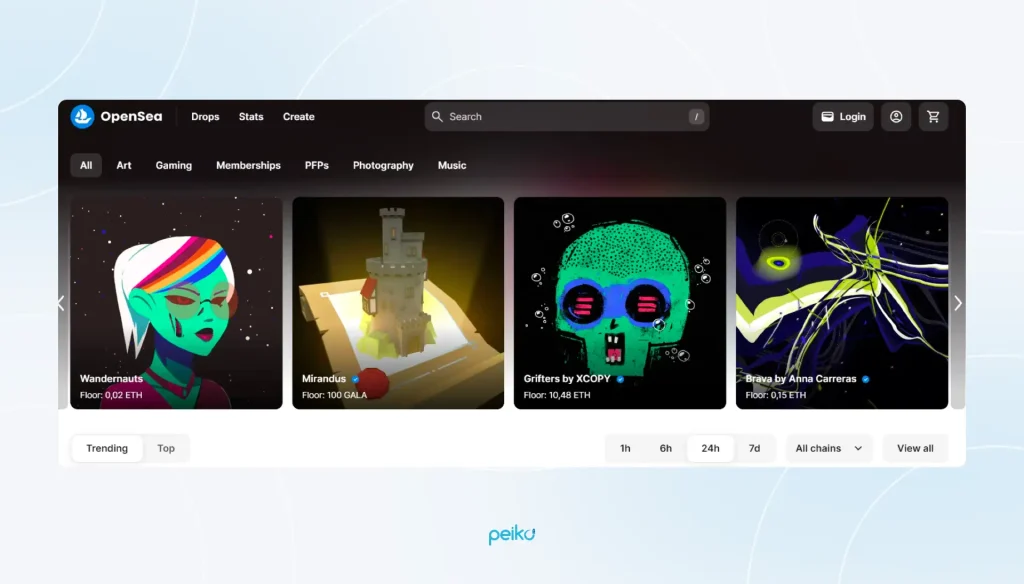
The benefits of NFT marketplace
Moreover, an increasing number of individuals seek to invest in a democratized economy with fewer hurdles and constraints than traditional investment systems.
Beyond the aforementioned advantages, let’s delve into additional benefits of NFT marketplace platform development:
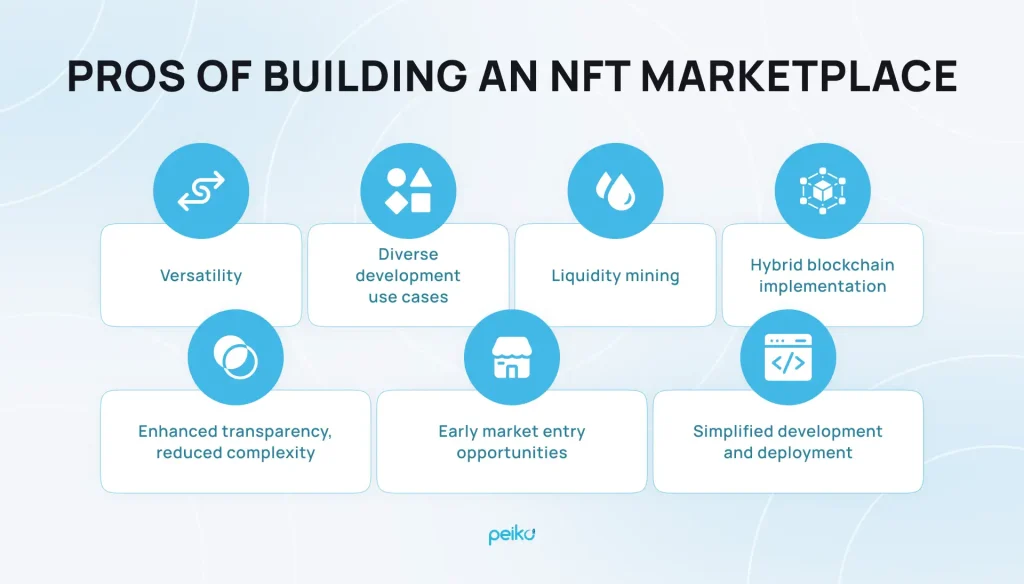
Versatility
The versatility of NFT marketplaces lies in their ability to tokenize virtually anything, including rare posters, video clips, tweets, memes, code, puzzles, recordings, and autographs.
Diverse development use cases
These platforms intersect various industries, including finance, fintech, cryptocurrency, digital tokens, crypto wallets, and more, fostering innovation and offering endless business opportunities.
Liquidity mining
Liquidity mining entails rewarding users with crypto tokens. These tokens can be utilized for accessing rare items, voting, participating in auctions, submitting new ideas, or trading on cryptocurrency exchanges for profit.
Hybrid blockchain implementation
Leveraging hybrid blockchains and multiple blockchain networks within NFT marketplaces enables the integration of many features and functionalities that cater to a broad range of business use cases.
Enhanced transparency, reduced complexity
Built on blockchain technology, these marketplaces ensure secure, transparent transactions without the complexities associated with traditional online platforms.
Early market entry opportunities
While saturation may eventually occur in the NFT marketplace and blockchain-based businesses, there exists a window of opportunity for experimentation and testing of various business approaches.
Simplified development and deployment
Given the nascent stage of NFT marketplace app development, particularly in customizable solutions, creating and deploying these platforms is relatively straightforward.
How do NFT marketplaces work?
If you are looking for the answer to the question on how to build an NFT marketplace, it is vital to understand the full development process. Below, we will consider the mechanics behind this process:
Token generation
- User registration: Users initiate their journey by registering an account on the marketplace.
- Digital wallet: This wallet is compatible with different currencies and is an essential component of NFT storage.
- Minting: Through a process termed “minting,” users transform digital files into NFTs
Buying and selling
- Listing: Minted NFTs are showcased for potential buyers.
- Browsing and searching: Buyers navigate through listings either manually or via search functionalities.
- Acquisition: Upon selection, NFTs are purchased and transferred to the purchaser’s digital wallet.
Trading and auctions
- Trade proposals: Users can engage in NFT trading, often facilitated by bidding mechanisms.
- Auctioning: Alternatively, NFTs can be auctioned off to the highest bidder.
Transaction validation
- Smart contracts: Transactions are securely executed through smart contracts.
- Blockchain ledger: Each transaction is recorded permanently and securely on the blockchain.
Fees and charges
- Transaction costs: Both transacting parties may require fees comprising those mandated by the marketplace and the blockchain.
Things to consider when creating an NFT marketplace
Before you start to create NFT marketplace, it’s imperative to consider a few key factors to create a project that will be successful. Below, we’ve outlined these crucial points:
Transparency
Make your marketplace transparent, showing transaction history and users’ activity to create trust among them.
Security
Establish a high level of security that would prevent users’ data and assets from being hacked or fraudulently obtained by incorporating advanced encryption and multi-signature wallets.
Decentralization
Adopt a decentralized concept that gives power to the user-the right to retain their assets-and build trust within the marketplace.
The Monetization Model
Clearly define the revenue model, balancing profitability with user satisfaction. This could be in the form of transaction fees, advertisement, or royalties to creators.
Smart Contracts
Use specific smart contracts for managing transactions, listings of assets, and interactions between users for secure and automated operations in your marketplace.
At Peiko, we boast a track record of successfully completing blockchain projects. Check out our comprehensive portfolio, which showcases our expertise in complex architecture and robust Web 3.0 blockchain technology stack.
How to create NFT marketplace?
The development of the NFT marketplace presents an opportunity for both startups and established enterprises to generate profit in the dynamic NFT market.
At Peiko, our approach to the NFT marketplace development process comprises several key steps aimed at ensuring a tailored and robust platform:
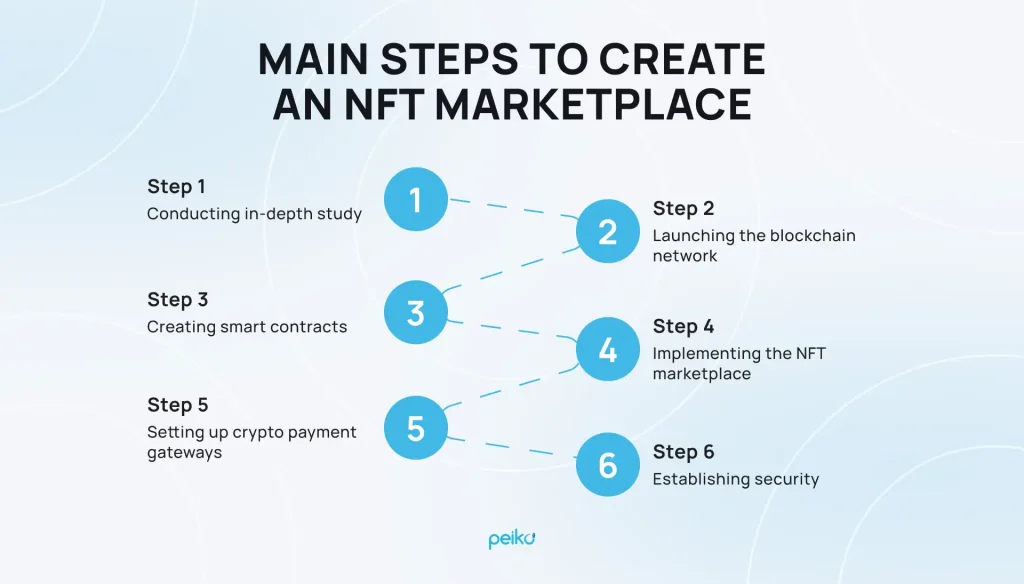
Step 1: Conducting in-depth study
Begin by determining your target audience and understanding their expectations from a marketplace solution. Key considerations for this step include:
- What kind of items or non-fungible tokens do you intend to trade and feature on your marketplace?
- Are you targeting an international audience or a local area?
- Which wallets, features, and types of NFT trading do you plan to offer?
- If your focus is on artists and creators, what specific services, features, and information flow should be incorporated into your marketplace?
At Peiko, we conduct thorough market analysis to identify the target group and potential niches within the NFT market, such as artworks, sports memorabilia, gaming assets, music, or real estate.
Step 2: Launching the blockchain network
Tailoring our approach to your unique requirements, we strategically select the most suitable blockchain network to serve as the foundation for your NFT marketplace. Should you desire a closed ecosystem for NFT distribution and trading among a select group of individuals, our experts possess the expertise to build a bespoke private blockchain from scratch.
Step 3: Creating smart contracts
Next, our team works on the design and coding of smart contracts, the backbone of NFT creation and transaction execution. Through rigorous testing protocols, we validate the integrity of the smart contract code, mitigating any potential vulnerabilities that could compromise the security of your marketplace and providing users with peace of mind in their interactions.
Step 4: Implementing the NFT marketplace
Applying our technical prowess, we implement your vision in reality by crafting a sophisticated web-based marketplace boasting an intuitive and aesthetically pleasing user interface (UI).
Here are the integral steps we undertake during the design phase:
- Crafting a wireframe: This delineates the visual elements of your platform or application.
- Selecting style guides: They aid in envisioning the appearance of UI elements in your NFT platform.
- Creating mock-ups: These encompass both visual and structural features.
- Building a prototype: Prototypes serve to elucidate the functionality of your platform to users, akin to demo versions.
Step 5: Setting up crypto payment gateways
Facilitating frictionless transactions lies at the core of our ethos. We integrate market-leading cryptocurrency payment gateways such as CoinGate, BitPay, and Coinbase Commerce.
Step 6: Establishing security
Recognizing the paramount importance of safeguarding your marketplace against different cyber threats, we deploy a robust suite of cybersecurity measures. We design and implement comprehensive data backup protocols, accompanied by user-centric cybersecurity guides.
We also thoroughly test the solution before launching it. The positive reviews of our clients on projects we developed, like the Poof App, confirm our expertise in software and blockchain development. Our team can help you with further support for your marketplace.
Try our help!

Top NFT marketplace development tools
The creation of an NFT marketplace involves leveraging different services and tools tailored for specific purposes. Below, we will consider some commonly used NFT marketplace development tools:
Smart contract development tools
Smart contracts serve as the foundation of any NFT marketplace, facilitating the creation, transfer, and management of diverse digital assets. Solidity is a renowned tool for crafting smart contracts across various Blockchain platforms like Binance Smart Chain or Ethereum.
The Truffle Suite stands out as one of the top frameworks streamlining the NFT marketplace development process. This tool helps to enhance the testing and deployment of smart contracts and bolsters efficiency and reliability.
Blockchain platforms
Selecting the appropriate blockchain platform is crucial for establishing an NFT marketplace.
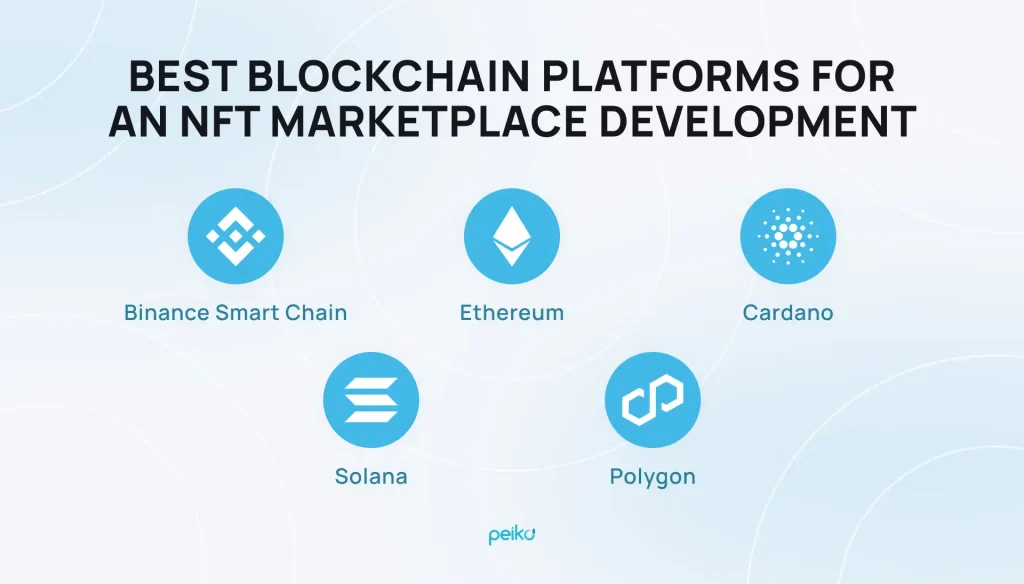
- Binance Smart Chain: Offers scalability and cost-effectiveness, presenting an appealing alternative for developers seeking Ethereum-compatible solutions.
- Ethereum: This blockchain platform is widely favored for its support of ERC-721 and ERC-1155 standards.
- Cardano: This blockchain can boast its focus on scalability, sustainability, and interoperability.
- Solana: It is recognized for its high-performance blockchain network, which can process thousands of transactions per second with low fees.
- Polygon: Formerly known as Matic Network, Polygon is a layer 2 scaling solution for Ethereum that enhances its scalability and reduces transaction costs.
Wallet SDKs
Integration of a wallet is essential for seamless user interaction with NFTs. MetaMask facilitates asset management and dApp interaction on Ethereum-based platforms. For example, WalletConnect facilitates secure communication between mobile wallet applications and dApps, enhancing accessibility across various platforms.
Databases
They can differ in terms of data structure and decentralization:
- IPFS: Ensures accessibility and immutability without reliance on centralized servers and enables the distribution of files across a network of nodes.
- MongoDB: Provides flexibility in schema design, making it suitable for NFT marketplaces dealing with diverse metadata structures and asset types.
- PostgreSQL: Its extensibility and SQL compliance make it a versatile choice for NFT marketplace development, accommodating complex data models and query requirements.
- MySQL: This database solution offers strong ACID compliance, ensuring data consistency and reliability critical for NFT marketplace transactions and user interactions.
Frontend frameworks
Developers employ frontend frameworks like React and Angular to design intuitive user interfaces for non-fungible token applications. These frameworks offer scalability, robustness, and a vast ecosystem of tools and libraries.
Security auditing services
Comprehensive security audits are vital for finding and mitigating potential vulnerabilities in smart contracts. Services like OpenZeppelin and CertiK specialize in smart contract auditing, utilizing code analysis and testing to address security flaws effectively.
Payment gateways and integration APIs
These tools are vital for facilitating smooth transactions within non-fungible token marketplaces. Platforms like Stripe and Coinbase Commerce offer robust payment processing solutions, supporting fiat-to-cryptocurrency conversion and ensuring a seamless user experience.
Challenges in NFT marketplace software development
When you build NFT marketplace from scratch, various challenges may arise. Here are several common hurdles, along with strategies to address them:
- Evolving regulations: The field of NFTs is relatively nascent, leading to ambiguity in regulatory frameworks. Staying abreast of legal developments and collaborating with legal professionals versed in the Web3 marketplace development industry is imperative.
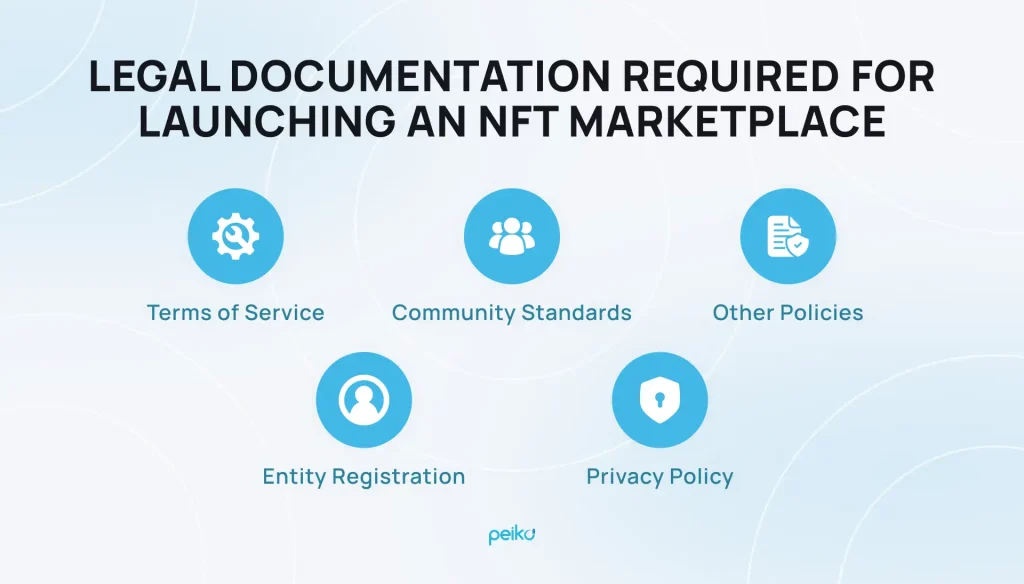
- Copyright concerns: Selling NFTs involves trading digital art, music, and other creative assets, raising potential copyright issues. To preempt this, clear policies and guidelines for users must be established, and their rights to trade their NFTs must be verified.
- Ensuring user safety: Security is paramount in the Web3 realm, and users must feel secure within your marketplace. Prioritize safeguarding users’ information and digital assets to foster trust and encourage marketplace utilization.
- Distinguishing your platform: With the rising popularity of NFT marketplaces, distinguishing your platform becomes increasingly challenging. Emphasize valuable features, prioritize user-centricity, and deliver a seamless experience tailored to your target demographic.
- NFT ticketing: The integration of NFT ticketing into your marketplace holds immense value but is not without its challenges. Verifying tickets for authenticity to avoid scalping or fraud requires a very thorough process.
Advanced blockchain development by Peiko
At Peiko, we excel in software and blockchain development services and have extensive expertise, proven by many client reviews on well-known platforms such as Clutch. Our portfolio includes various projects, such as crypto wallets, crypto exchanges, ecommerce NFT platform development projects, Telegram crypto integrations, and more.
Take, for instance, Quan2um, a cutting-edge cryptocurrency exchange that facilitates the seamless purchasing and selling of Bitcoin Additional, Bitcoin, and various altcoins. Renowned for its top-tier security adhering to European standards, Quan2um has a bonus system for new users and a multi-level commission structure.

In our NFT marketplace development process, we tackled implementing a versatile resource management system. This system needed to offer flexible settings, enable seamless role management, and straightforwardly handle coins and trading pairs.
Central to the https://peiko.space/case/quan2um was the integration of a robust matching system for user bidding. This system was designed to accommodate various order types, facilitating both buying and selling transactions.
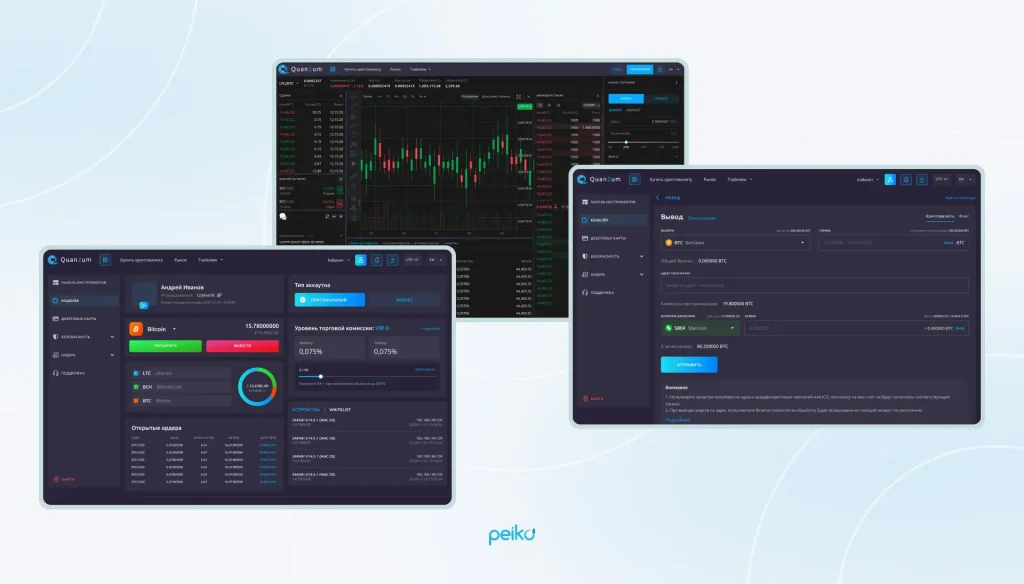
To incentivize user growth, we introduced a dynamic referral program. Existing users were rewarded with bonuses for inviting friends to register and fostering community expansion. We also ensured our platform’s visibility by indexing it with search engines, culminating our efforts with comprehensive accessibility and reach.
Turn to us if you need a reliable NFT marketplace or any other blockchain project like medical & healthcare website development, for example. With Peiko, your blockchain endeavors are in capable hands.
How much does it cost to build NFT marketplace from scratch?
The cost varies depending on project specifics, including desired functionalities, chosen technology stack, and features. Factors such as integrations, blockchain platforms, and API integrations significantly influence development costs. Project complexity and the ecommerce NFT platform development duration also impact overall expenses.
Outlined below is a tabulated overview of ecommerce NFT platform development costs to provide a general understanding:
| Feature | Cost range |
|---|---|
| Admin panel | $3000 – $10,000 |
| Author panel | $5000 – $14,000 |
| Authorization and security | $3000 – $8000 |
| Buyer panel | $3000 – $7000 |
| Ethereum incorporation | $4000 – $11,500 |
| Home page | $3500 – $5,000 |
| Inventory management | $2000 – $5000 |
| NFT management | $4000 – $11,500 |
| Notifications | $1000 – $2000 |
| Payments | $2000 – $5000 |
| Reviews & ratings | $1000 – $2000 |
| Product page | $2000 – $5000 |
| Search and filters | $4000 – $11,500 |
| Shopping cart | $2500 – $5500 |
| UX/UI development | $2200 – $5000 |
So, the total NFT marketplace development cost is estimated between $45,000 – $125,500. For precise price, turn directly to your Web3 development services provider.
Final thoughts
Now that you’ve got the answer to the question of how to create your own NFT marketplace. If you’re not well-versed in the tech aspects, turning to an experienced blockchain development firm becomes essential. The reliable development service provider will build NFT marketplace from scratch according to the specific requirements of your user base.
At Peiko, we are always glad to help. Turn to our company, which specializes in software and blockchain creation. We will build a dependable, secure, and intuitive NFT marketplace related to your needs.





